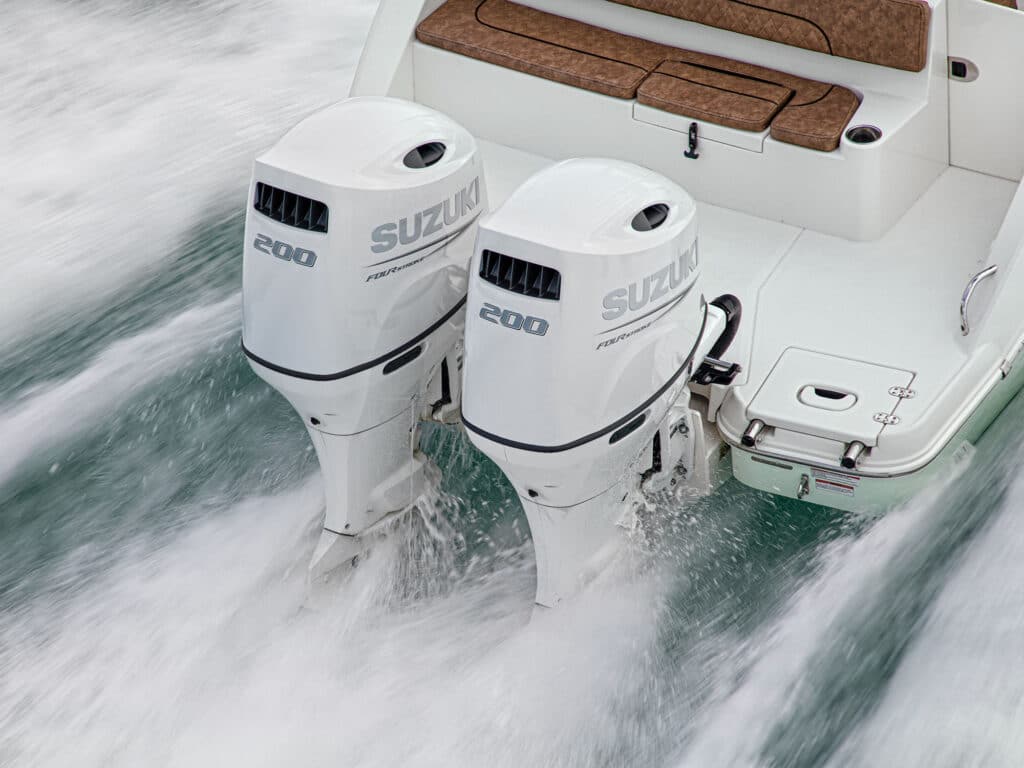
Suzuki outboards are often the first choice of charter and commercial captains when they repower their boats. When properly maintained, Suzuki reliability equals or exceeds the competition and, due to the design of these outboards, most routine maintenance is easily accomplished by the owner. After having run a pair of DF200AP four-cylinder motors with digital controls on a center-console off Cape Cod and another pair aboard a pontoon boat on Mellen Lake in Michigan, I saw other reasons to like Suzuki’s latest offering in marine propulsion.
Fuel efficiency is strong thanks to lean-burn technology that balances the fuel and air mixture to meet the load. The motors are quiet thanks to a resonator system for exhaust noise and rubber mounting bushings that dampen noisy vibrations. The quiet operation of the motors at idle often leads bystanders to ask, “Is it running?”
Variable valve timing provides the torque needed to get on plane quickly, as well as power and speed in the upper rpm ranges. An oil-bathed, offset crankshaft shifts the motors’ center of gravity forward, improving performance on many boats. And Suzuki power comes from large displacement blocks, not turbos or blowers. There is no replacement for displacement, say Suzuki engineers.
While all this has been baked into Suzuki motors for a long time, the more recent AP series brings a level of digital control to boaters not seen before. Digital readouts communicate beautifully on Suzuki’s multifunction displays (and third-party MFDs via NMEA 2000 networking), presenting even small-boat owners with a “glass cockpit” option not always accomplished easily. Full engine stats, fuel burn, temperature and oil pressure are just the beginning. Further, the Suzuki diagnostics mobile phone app monitors operating hours and conditions, cues the owner to needed fluid changes, and offers tips on more efficient running based on operating characteristics to date.
Suzuki’s AP motors have various temperature sensors installed throughout the power head, each with a monitoring algorithm that knows what temperature that “zone” of the motor should be and how soon it should achieve that temp. If temps exceed expectations or warm too quickly, the ECM assumes there is a coolant blockage—for instance, a weed or a garbage bag—which increases the likelihood the display will report the issue before it becomes a problem.
Digital throttle and shift makes the controls not only smoother but also intuitive. When putting your boat in a turn, the system manages the load by automatically feeding fuel and air to maintain horsepower and speed through the turn instead of bogging down and falling off plane like mechanically controlled motors often do.
Read Next: Suzuki Marine Outboard Controls
While Suzuki has been a powerful force in saltwater and repower markets, inland boaters are beginning to see several new benefits. With a strong reputation for corrosion resistance in salt water, freshwater boaters can expect Suzuki motors to stand up well in the less-harsh sweet water.
For pontoon operators, Suzuki’s high-gear reduction ratio means the motor can turn larger-diameter props, giving them better control at slow speeds—an enormous advantage for a hull style that is notoriously cumbersome in tight quarters and at slow speeds.
Color choices now include Cool White and Pearl Nebular Black (in 4 hp to 350 hp) for pleasing color combinations to go along with the motors’ pleasing operation.









